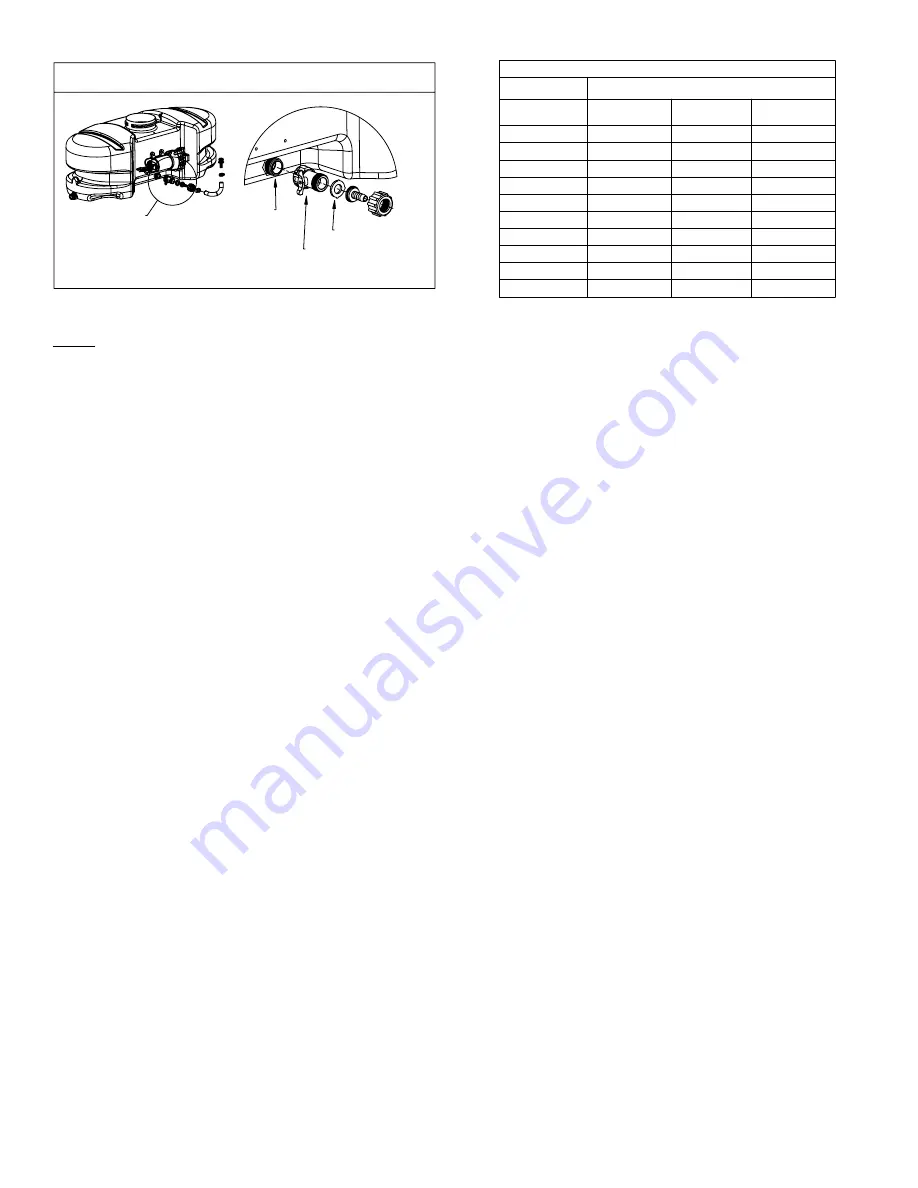
"ON/OFF" Valve
*** IMPORTANT REMINDER ***
A
Inlet from Tank
Filter/Screen
Detail A
"open" position before using your sprayer.
You must make sure the valve is in the
tank, towards the underside. (See Detail A).
valve located at the inlet location of the
This sprayer comes with an On/Off (shut-off)
Time Required in seconds to travel a distance of:
200 Ft.
(Miles per Hour)
100 Ft.
2.0
3.0
1.0
5.0
6.0
7.0
9.0
8.0
10.0
4.0
15
7.6
6.8
14
68 sec.
17
8.5
9.7
11
14
34
23
34
17
19
23
27
136 sec.
68
45
Speed in M.P.H.
Speed Chart
300 Ft.
23
20
51
34
41
29
26
68
102
205 sec.
Page 2
Operation
Your sprayer is equipped with (2) ON/OFF switches. One is on
the wire assembly that you hook up to your battery, the other is
on the pump itself, on the opposite end of the pressure switch.
The "-" is the "ON" position and the "o" is the "OFF" position for
the switches. Make sure both switches are depressed in the "-"
position for operation.
In addition to the ON/OFF switch, the pump is equipped with
an electronic pressure switch that is factory pre-set for it to
shut off at 45 p.s.i.. This switch assembly is the 'square box' on
the head portion of the pump.
Always fill the tank with a desired amount of water first, and
then add the chemical slowly, mixing as you pour the chemical
into the tank. You may use the handgun to spray into the
solution in order to mix the chemical and water.
Initially begin spraying by opening the handgun. This will
enable the air in the line to be purged through the handgun tip,
while building pressure.
The pumping system draws solution from the tank, through the
strainer/filter, and to the pump. The pump forces the solution
under pressure to the handgun and/or boom nozzles.
Open the handgun by squeezing the handle lever.
•
Rotating the adjustable nozzle tip on the handgun will
•
change the tip pattern from a straight stream to a cone
pattern (finer mist).
The pump's electronic pressure switch shuts the motor off
•
when all lines are closed. The system will remain
pressurized, and the pump motor will restart automatically
when either the handgun, or boom line is opened. If the
bypass line valve is in the open position, the pump will not
shut off automatically.
Both nozzles spraying at the same time will allow a
•
maximum coverage of 28 feet.
When it becomes necessary to clean the screen, you will
•
need to shut off the ON/OFF valve down by the tank, on
the inlet side of the pump. Next, unscrew the knurled nut on
the outside of that valve. Remove the screen/washer which
is located in the knurled nut at that location. Rinse and tap
out the dirty screen and put back in it's original position
when clean. Do this on a regular basis to maintain a clean
screen.
Adjusting Pressure
- When the bypass valve is closed, pressure is at the highest
point.
- Opening the valve will decrease pressure.
Testing the Sprayer
NOTE:
It is VERY important for you to test your sprayer with plain
water before actual spraying is attempted. This will enable
you to check the sprayer for leaks, without the possibility of
losing any expensive chemicals.
Add water to the tank & drive to the starting place for spraying.
When you are ready to spray, turn the boom valves to the "on"
positions. This will start solution spraying from the tips of the
boom. The pressure will decrease slightly when the boom is
spraying. Adjust the pressure by turning the "ON/OFF" valve lever
on the bypass line valve.
Read the operating instructions and Initially begin spraying by
closing the 'bypass' valve (this is the center ON/OFF valve
located at the center port of your manifold assembly) and opening
the boom line "Y" valves. This will enable the air in the lines to be
eliminated (purged) through all the tips, while building pressure.
When everything tests all right (no leaks, & good pressure), add
the desired chemicals to the mixture and water combination and
start your spraying operation. Adjust the pressure and spray as
you did in the testing procedure.
Conditions of weather and terrain must be considered when
setting the sprayer. Do not spray on windy days. Protective
clothing must be worn in some cases.
Be sure to read the chemical label(s) correctly!
Calibration
Chemical labels may show application rates in gallons per acre,
gallons per 1000 square feet, or gallons per 100 square feet. You
will note that the tip chart shows all 3 of these rating systems.
Once you know how much you are going to spray, then
determine (from the tip chart) the spraying pressure (PSI), and
the spraying speed (MPH).
Determining the proper speed of the pulling vehicle can be done
by marking off 100, 200, & 300 feet. The speed chart indicates
the number of seconds it takes to travel the distances. Set the
throttle and with a running start, travel the distances. Adjust the
throttle until you travel the distances in the number of seconds
indicated by the speed chart. Once you have reached the throttle
setting needed, mark the throttle location so you can stop and go
again, returning to the same speed.
Add water and proper amount of chemical to the tank and drive
to the starting place for spraying.
























